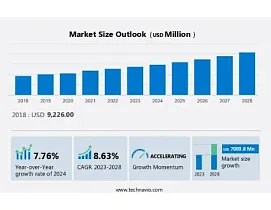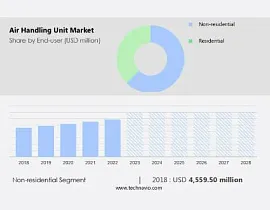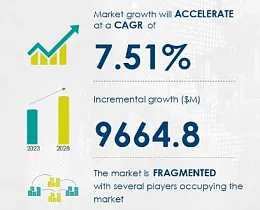The Air Conditioning (AC) Systems Market size is forecast to increase by USD 47.02 billion, at a CAGR of 6.46% between 2023 and 2028. The emerging trend of increased demand for smart air conditioning systems is shaping market growth. Factors driving this surge include technological advancements, energy efficiency awareness, and comfort convenience desires. Technological progressions, such as intelligent sensors and internet connectivity, optimize energy usage. Additionally, remote system control adds convenience, especially when users are away. However, the market faces challenges, notably the high upfront costs of energy-efficient AC systems.
Despite long-term benefits, these costs deter buyers, particularly in segments like commercial and industrial air conditioning. Government regulations can incentivize adoption. Market analysis and reports suggest a shift towards intelligent features and inverter and non-inverter technology. The market caters to various end users in residential, commercial, and institutional buildings, available through online stores. Both unitary and rooftop ACs, along with split and window units, serve diverse environments from offices and retail spaces to manufacturing plants and healthcare facilities.
What is the Largest-Growing Segments in the Market?
The residential segment is estimated to witness significant growth during the forecast period. With the rising global temperatures and increasing disposable income of people, the demand has witnessed substantial market growth analysis, particularly among residential consumers. One of the primary drivers of the residential segment in the market is the growing urbanization and population shift toward urban areas.
The residential segment was the largest and was valued at USD 40.88 billion in 2018. The residential segment in the AC systems market is highly competitive, with numerous manufacturers and suppliers catering to diverse customer requirements. AC-systems market players are investing in research and development activities to introduce innovative and technologically advanced. These systems often integrate smart features, such as remote control operation, IoT connectivity, and energy consumption monitoring, to enhance user experience and improve energy efficiency. Thus, the residential segment in the market is expected to witness significant growth during the forecast period.
Which are the Key Regions for the Market?
APAC is estimated to contribute 51% to the growth of the global market during the forecast period. Technavio’s analysts have elaborately explained the regional market trends and analysis and drivers that shape the market during the forecast period. APAC, known for its large population and increasing urbanization, has created a strong demand for cooling solutions across various sectors such as residential, commercial, and industrial. The APAC region experiences extreme climates, particularly in countries such as India, Singapore, and Australia. This further drives the need for air conditioning-systems to provide relief from hot and humid conditions. As a result, both centralized and decentralized air conditioning solutions have gained popularity in these regions.
Additionally, the growing awareness about energy-efficient technologies and environmental concerns has led to the adoption of energy-efficient alternatives in APAC. Governments and regulatory bodies are promoting the use of eco-friendly cooling solutions, which use less power and have lower carbon emissions. This has further influenced the market dynamics, with both manufacturers and consumers embracing sustainable practices. Thus, the market in APAC is anticipated to witness robust market growth and forecasting during the market forecast period.
Market Dynamics and Customer Landscape
The market is witnessing increasing demand driven by the need for energy-efficient products and the rise in urbanization. A prominent trend in this market is the increased demand for smart air conditioning systems, reflecting a shift towards more technologically advanced and environmentally friendly solutions. However, a significant challenge facing the industry is the high upfront costs associated with energy-efficient and sustainable AC systems, particularly in regions like the Gulf countries where climate change and urban heat island effects intensify the need for effective cooling solutions.
Key Market Driver
The market growth for energy-efficient HVAC systems is significantly driven by increasing demand. Amidst climate change concerns and resource depletion, there's a heightened awareness of energy conservation and environmental impact reduction. HVAC systems, crucial for indoor comfort and air quality in residential, commercial, and industrial buildings, face scrutiny for their energy consumption. Traditional systems often lead to high electricity bills and greenhouse gas emissions. Thus, there's a surge in demand for energy-efficient alternatives, including systems with intelligent features, inverter technology, and higher Seasonal Energy Efficiency Ratio (SEER). This demand spans across residential and commercial end users, encompassing various segments like unitary segment, non-inverter segment, commercial segment, central air conditioning systems, split air conditioning systems, window unit air conditioning system, ductless mini-split systems, room air conditioners, commercial air conditioning, and packaged air conditioners, meeting the needs of office buildings and beyond.
Significant Market Trends
Increased demand for smart air conditioning systems is an emerging trend shaping the market growth. This surge in demand can be attributed to several factors, including technological advancements, growing awareness about energy efficiency, and the desire for enhanced comfort and convenience. Technological advancements have played a crucial role in the rise of smart air conditioning systems. These systems utilize intelligent sensors, intelligent and connected features, internet connectivity, and automation to provide efficient cooling solutions. With the help of sensors, smart air conditioners can detect the occupancy of a room and adjust the temperature accordingly, optimizing energy usage.
Who are the Major Market Companies?
The research report also includes detailed analyses of the competitive landscape of the market and information about 20 market companies, including:
- Alfa Laval AB
- Carrier Global Corp.
- Daikin Industries Ltd.
- Electrolux AB
- Emerson Electric Co.
- Gree Electric Appliances Inc. of Zhuhai
- Haier Smart Home Co. Ltd.
- Hisense International Co. Ltd.
- Hitachi Ltd.
- Johnson Controls International Plc
- LG Electronics Inc.
- Panasonic Holdings Corp.
- Samsung Electronics Co. Ltd.
- Sharp Corp.
- Siemens AG
- Midea Group Co. Ltd.
- Toshiba Corp.
- Trane Technologies plc
- Whirlpool Corp.
- Mitsubishi Electric Corp.
Read More





